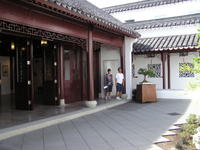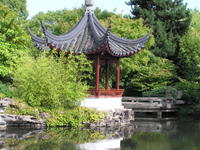Dr. Sun Yat-Sen Classical Chinese Garden

The family always passes by the Dr. Sun Yat-Sen Classical Chinese Garden every time they go downtown. This gem in Chinatown is one of Vancouver's attractions, and not once has the family visited it since they landed in B.C. almost 10 years ago.
So, one Saturday evening, Lyn decided that they visit this tourist magnet. Of course, Raf wasn't crazy about the idea of the family visiting Chinatown, particularly its wet sidewalks lined with shops hawking seafood, fruits and vegetables, and herbs. He didn't like the fishy smell, either. To convince him to come with them, Ronnie and Lyn told him that they're going to the "drier" part of Chinatown where they sell clothes, handicrafts and toys. Plus, eating out after the visit also helped. With that settled and a sunny Sunday weather forecast, the three went there the next day.
Constructed in March 1985, the Dr. Sun Yat-Sen Classical Chinese Garden is the first full-scale classical scholar's garden made outside China. The design of the $7.2 million garden is based on the private classical ones constructed in the city of Suzhou in the Ming Dynasty (1368–1644) and built using Chinese materials, tools and techniques.
Backtracking a little bit, the three proceeded to the China Maple Hall Courtyard, the main garden. The"It looks like one of the scenes from that Tenchu video game of yours," Lyn describing the area's interiors and exteriors.
"Hmmm, old lacquered Chinese fir smells funny," Ronnie, when he leaned on one of the room's wooden pillars.
"We're going the wrong way," Raf looking at the map.
 coutryard ground was covered with intricate patterns made from rocks and pebbles, and painstakingly and artfully laid by hand. But the focal point of the area was the ting, an elegant pavilion, piled high on naturally shaped Tai Hu limestone rocks from Lake Tai in Suzhou, China. And all around were penjing, the forefather of the Japanese bonsai.
coutryard ground was covered with intricate patterns made from rocks and pebbles, and painstakingly and artfully laid by hand. But the focal point of the area was the ting, an elegant pavilion, piled high on naturally shaped Tai Hu limestone rocks from Lake Tai in Suzhou, China. And all around were penjing, the forefather of the Japanese bonsai.
Compared to other gardens in the the province, the Dr. Sun Yat-Sen Classical Chinese Garden is relatively small. However, it was like looking at a scroll painting where the viewer is offered with a succession of changing landscapes. And now that the visit was over, the main question that lingered in Raf's mind was: "So, where do we eat?" •

0 Comments:
Post a Comment
<< Home